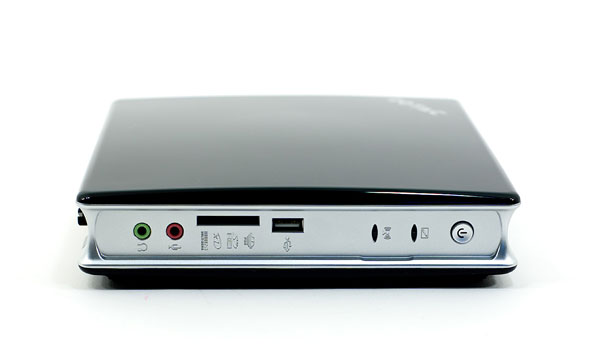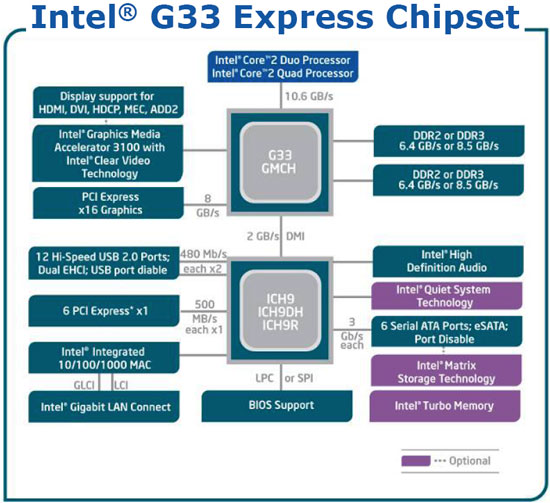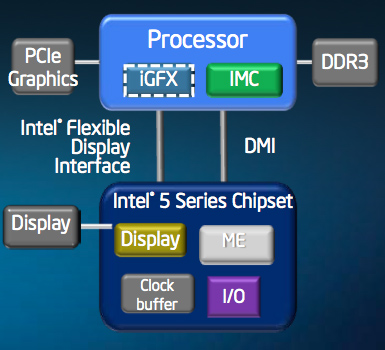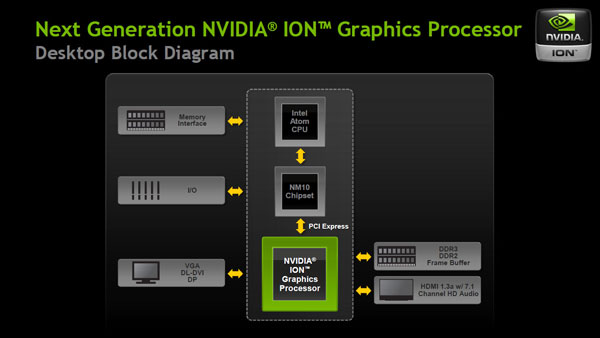Zotac ZBOX HD-ID11 Review: Next Gen ION is Better & Worse than ION1
by Anand Lal Shimpi on May 6, 2010 3:51 PM EST- Posted in
- GPUs
- Next Generation ION
- HD-ID11
- ZOTAC
- NVIDIA
The nForce 2 was one of the best chipsets to come out of NVIDIA. It was NVIDIA’s second attempt at a desktop chipset yet it cemented NVIDIA’s position as a leading provider of core logic in the market. Oh how much has changed since then.
Most of what made a chipset worthwhile is now integrated into the CPU. It used to be memory controller optimizations that kept chipsets afloat, but that’s no longer the case as all x86 processors now ship with an integrated memory controller. The performance differences between chipsets disappeared and all that was left was testing, validation and drivers, also known as the boring, expensive and time consuming aspects of chipset development.
NVIDIA has mostly abandoned the chipset business, focusing on opportunistic wins where possible. The most obvious example is with ION, its chipset/GPU for Atom based systems.

Last year we played with a number of ION systems and motherboards and were generally impressed. The platform made for a powerful little HTPC. Today we’re able to bring you a hands on performance preview of the first Next Generation ION box we’ve laid our hands on: the Zotac ZBOX HD-ID11.
Terms of Ndearment
CPUs connect to the outside world using proprietary bus interfaces. AMD uses Hyper Transport, while Intel previously used the AGTL+ FSB. In order to build a device that hangs off of this interface you need a license to use it. This is just an IP license to let you integrate the circuitry you need to communicate over that bus onto your silicon. It’s pretty commonplace.
Over the years Intel would update its FSB (Front Side Bus) specification, and it would threaten its chipset partners with revoking their license to the new version of the FSB unless they cooperated. Intel and VIA had a disagreement over this years ago that ended in VIA threatening Intel with CPU patents and the two coming to terms later on.

The old way of doing things, FSB between the CPU and the GMCH, DMI between the GMCH and ICH.
With Nehalem, Intel moved away from a parallel bus interface and introduced QPI (Quick Path Interconnect). This is a very high bandwidth point to point protocol designed for high end servers, workstations and desktops. It’s used in the Nehalem and Gulftown based Core i7s. NVIDIA said it had no interest in pursuing a QPI based chipset, so the issue of licensing never came up.

The new way, QPI between the CPU and IOH. DMI between the IOH and ICH.
A much lower bandwidth interconnect called DMI (Direct Media Interface) would be used for mainstream Nehalem/Westmere derivatives (e.g. Core i3, Core i5, LGA-1156 Core i7). Intel had used this interconnect in the past to connect parts of its chipsets together, but now it would be used to connect the CPU to a chipset.

The other new way: DMI between the CPU and chipset.
With its own aspirations of getting into the GPU market, and no real need for NVIDIA’s allegiance, Intel enforced its license agreement and threatened a lawsuit if NVIDIA sold chipsets that used Intel’s DMI. NVIDIA argued that it was well within its rights to do so but didn’t want to risk it and stopped development on DMI chipsets pending the outcome of its lawsuit against Intel for violating the terms of the license agreement.
The ION Problem
While all of this was going on, Intel’s Atom platform started gaining momentum in netbooks and nettops. The netbook version of Atom used the old AGTL+ FSB to connect to its chipset, so NVIDIA could technically produce chipsets for it. Which is exactly what NVIDIA did. It was called ION (and later renamed to Atom + ION).
The latest version of Atom for netbooks/nettops, codenamed Pineview, integrates the memory controller and graphics core. Its only connection to the outside world is, you guessed it, a DMI link.

In a Pine Trail Atom system, the Pineview CPU connects to Intel’s NM10 Express chipset over this DMI link. With no license for DMI and no desire to push its luck, NVIDIA can’t offer a drop in replacement for the NM10 Express chipset.
Luckily, Intel’s NM10 Express Chipset includes four PCIe 1.0 lanes. A motherboard manufacturer could simply hang a low end, discrete GPU off of these PCIe lanes and you’d get a modern ION platform. And that’s what NVIDIA did for its Next Generation ION.
Meet NG-ION
NVIDIA’s Next Generation ION is a 40nm discrete GPU based on the GT218 core, it’s effectively the same GPU as a desktop GeForce 210 video card with some differing clock speeds. The nettop version uses 16 cores, while the netbook version uses 8 or 16 depending on the screen size.
While manufacturers can use all four PCIe 1.0 lanes coming off Intel’s NM10 Express chipset, most have chosen to use just one leaving the remaining lanes for things like WiFi. A single PCIe 1.0 lane can only provide 250MB/s of bandwidth in either direction, hardly enough for a modern GPU. It’s because of this limitation that the next-generation ION GPU could actually perform slower than the first ION.

As a discrete GPU, the NG-ION comes with its own frame buffer: up to 512MB of DDR3 on a nettop. You also get full H.264 video decode acceleration and support for 8-channel LPCM audio over HDMI out.















40 Comments
View All Comments
rnjeezy - Thursday, May 6, 2010 - link
and switch wifi to usbTekkamanraiden - Thursday, May 6, 2010 - link
While this looks pretty kick ass I'm looking forward to the Amd version. I'm curious how well the Neo processor with 3200 will do against the Aton with Ion2.Soulkeeper - Friday, May 7, 2010 - link
I too would like to see products from amd and/or via to compete here.I'm tired of "the intel show" 24/7
I wouldn't pay $100 for that ion thing
dealcorn - Friday, May 7, 2010 - link
As the Zotac NM10-B-E motherboard is shipping with HDMI and the Intel NM10 chipset, the Broadcom Crystal media solution is a viable build your own HTPC strategy that operates on fewer watts. I would have liked a side by side comparison.nick.cardwell - Friday, May 7, 2010 - link
Does this or any ION2 nettop use Optimus??? I am looking for a small D510 system to run headless and would be willing to buy an ION2 system strictly for the resale value if it uses Optimus to switch off that power hungry GPU. I am sill waiting on the Shuttle XS35 to show up as it is fanless.CZroe - Friday, May 7, 2010 - link
The comments in the article about manufacturers not wanting to reclaim PCIe lanes from WiFi and GbE don't sound so convincing. For example, they could easily integrate WiFi via internal USB or an Ethernet bridge.Heck, if nVidia wanted to make a real symbiotic chipset to go with this they could actually engineer a GbE/WiFi chip that uses multiple internal USB ports to achieve enough bandwidth. And by "enough" I mean "somewhat more than 100mbps but less than 1,000mbps." Users can't often maximize GbE because they need a GbE switch for full duplex and, assuming a max-speed file copy, a destination drive which can write as fast as the source can send. I doubt many users really need GbE over 10/100 Fast Ethernet/802.11n.
Also, what happened to all the rumors of an OC'd PCIe bus for ION2?
As for Zotac's design, I'd much prefer a larger, cooler, quieter design than this, especially if it is going in a home theater. If it would still be super-small, why not give it a proportionally huge HSF? The LEAST they could do is give it metallic housing and throw a heat pipe on it (even just one side).
rennya - Friday, May 7, 2010 - link
The latency guys, the latency.KaarlisK - Sunday, May 9, 2010 - link
Besides which, the NM10 chipset only has 1 USB2 controller, so no increase in bandwidth from ganging USB ports.modemide - Friday, May 7, 2010 - link
I enjoyed the article and this looks like a viable option for my next HTPC. However, I didn't see anything addressing the signal issues most people experienced with the initial version. Can you comment on that?Thanks.
Bateluer - Friday, May 7, 2010 - link
How come we don't see any of the ULV CPUs in form factors like this? I cannot imagine it'd be too difficult to stick in a Celeron SU2300, or a Pentium SU4100, or one of the ULV C2S chips. There's super netbooks that are thinner than these nettops that use these ULV chips. I can't imagine that designing a little beefier cooling system in the same Zotac chassis or into the Acer Revo chassis would be overly difficult. It may add a little to the price, but the trade off in performance might be worth it.